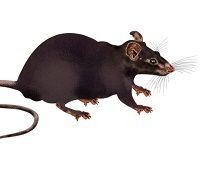Article
Epilepsy Drug Is Promising Rat Poison Antidote
Author(s):
Tetramethylenedisulfotetramine, a banned yet still available rat poison, is considered a potential terrorist weapon, largely because there is no specific antidote. Poisoning causes status epilepticus and death. Perampanel may be an antidote, researchers found.

Tetramethylenedisulfotetramine—a rat poison so dangerous it has been banned in the US and most other nations--is still widely available in China and sometimes shows up elsewhere in immigrant communities, as it did in 2002 in New York City. The poison can cause status epilepticus and death in humans and so far has no specific antidote.
The substance is easily manufactured and is considered a potential terrorist weapon.
But in a study presented at the American Epilepsy Society 69th Annual Meeting in Philadelphia, PA, researchers said that perampanel (Fycompa/Eisai) prevented death in lab animals exposed to tetramethylenedisulfotetramine (TETS).
The drug was administered at either 10 minutes or 40 minutes after the first myoclonic twitch. It stopped continuous convulsive activity, though it did not eliminate epileptiform discharges (periodic spikes and sharp wave activity and spike/sharp wave clusters).
“Mortality was prevented in 100% of animals receiving perampanel,” Dorota Zolkowska, PhD, of the University of California at Davis and colleagues concluded.
The poison has a colorful history, at least in China. According to an earlier report in Annals of Internal Medicine, though the rodenticide has been banned in China it is still easily obtained and has caused many intentional deaths, as well as accidental ones.
According to Annals authors K. Scott Whitlow, DO, an emergency physician at Kaweah Delta Health Care in Visalia, CA and colleagues, those include an incident in 2004 when 74 people were poisoned after they ate scallion-flavored pancakes. Reportedly, a rival pancake manufacturer intentionally spiked the pancakes eaten by the victims.
In another case, 76 college students were poisoned when someone deliberately put the rat-killer in their breakfast.
In 2002, New York City health officials issued a warning about the Chinese rodenticide after a NYC toddler accidentally ate some of it. The girl, 15 months old, “remained severely developmentally delayed and required pharmacological therapy for seizure control,” for at least six months after the incident, according to the Annals article.
In describing the poison’s mechanism, Whitlow wrote:
“Tetramethylenedisulfotetramine is an odorless, tasteless, white, crystalline powder that easily dissolves in water. The most common route of exposure is ingestion. Occupational exposures through inhalation have occurred, and it is not absorbed through intact skin . . . The compound binds noncompetitively and irreversibly to the chloride channel on the g-aminobutyric acid receptor complex (an inhibitory neurotransmitter in the central nervous system) of the neuronal cell membrane, where it blocks the influx of chloride and alters the intraneuronal potential. Tetramethylenedisulfotetramine, like picrotoxin from the plant Anamirta cocculus, or ‘‘fish berry,’’ is a ‘‘cage convulsant’’ with a similar mechanism of action (noncompetitive g-aminobutyric acidA receptor antagonism) and a cyclical or ring-like molecular structure 4,15,16.”
The UC Davis study was funded by the National Institute of Neurological Disorders and Stroke and the pharma company Eisai.




